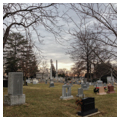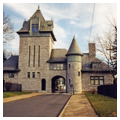Located on a limestone ridge overlooking the business district and enclosed by a delicate wrought-iron fence, the 50.5-acre complex contains four individual cemeteries. At the northwest corner are the ruins of Winchester's earliest Lutheran church. A stone front wall with round arches and a central doorway are all that survive from a fire in 1854. The impressive Richardsonian Romanesque limestone gatehouse (c. 1902, Barney and Chapman) was another gift of Charles Broadway Rouss (see FR16), wealthy patron of Winchester. The gatehouse consists of a large round-arched gated entrance flanked by a small cylindrical tower to the right and a massive three-story square tower to the left. The larger tower is capped by a steeply pitched pyramidal roof topped by a finial and adorned with Chateauesque dormers. The building contains an office, mortuary, living quarters for the superintendent, and a chapel in the left side with its rounded end. Stone-wall Cemetery (1866), located in the northern section of Mount Hebron, is one of the first dedicated Confederate cemeteries in Virginia. Encompassing five acres, the burial site includes the graves of 2,576 known and 829 unknown dead and contains a large stone monument to unknown Confederate soldiers.
Many of Winchester's most notable citizens are buried at Mount Hebron, including Virginia governor Frederick W. M. Holliday, governor and U.S. senator Harry F. Byrd, Confederate general Turner Ashby, Revolutionary War hero General Daniel Morgan, local historian Garland R. Quarles, and the first governor of Mississippi, David Holmes. Some of the tombs are highly elaborate, notably the mausoleum for Charles Broadway Rouss, which is a reduced version of the Parthenon in Athens. After his death in 1895, Judge John Handley was buried in a plot as close as possible to Stonewall Cemetery. His tomb is an open square pavilion with segmental arches, heavy corner buttresses topped by tall urns, and a hipped roof crowned by another urn. The iron gate and fence, now located along Pleasant Valley Road, was paid for by Rouss and was the original main gate for Mount Hebron. Built by Champion Iron Company of Kenton, Ohio, this tripartite gate is crowned with pediments and urns.





















